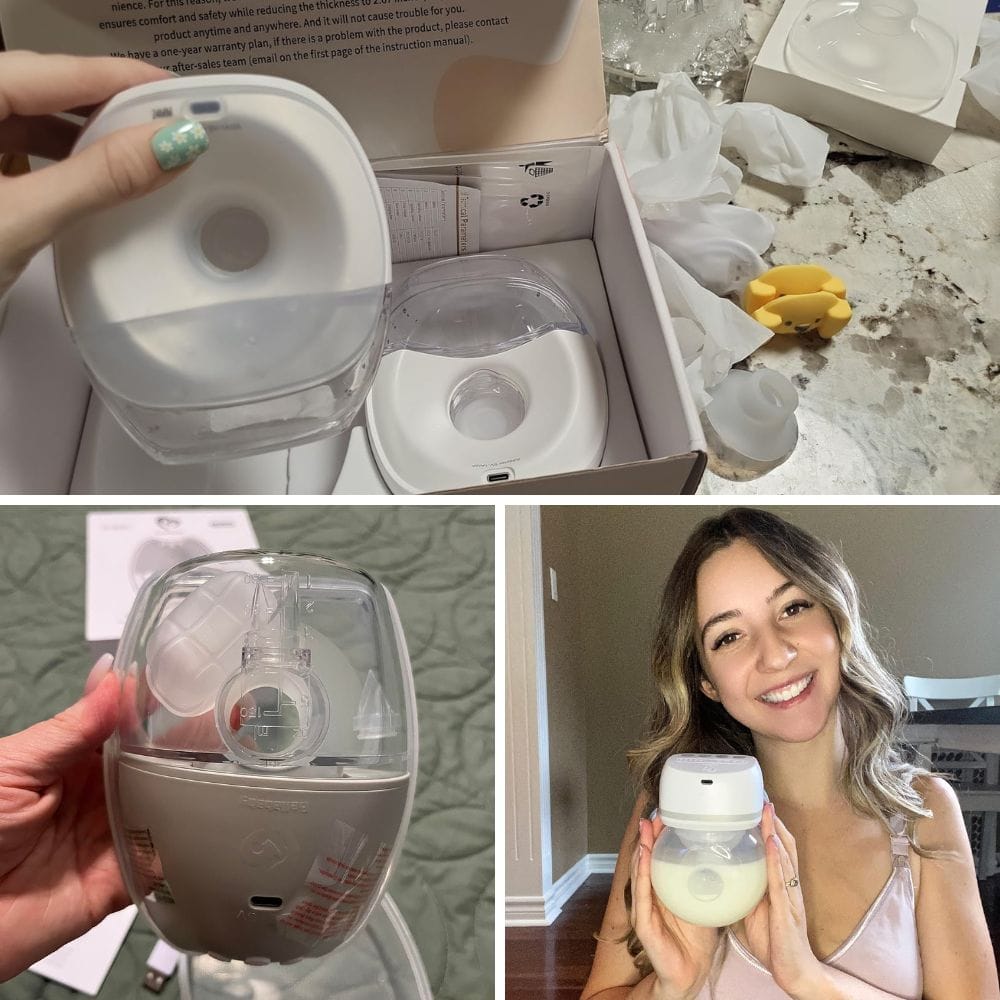Key Takeaways:
- Understanding the different types of breast pumps and their functionalities is crucial for effective milk expression.
- Proper usage and maintenance of breast pumps can significantly enhance milk supply and ensure the health and safety of both mother and baby.
- Consulting with a lactation consultant can provide personalized guidance and support for successful breast pumping.
Introduction
Breastfeeding is a natural and beneficial way to nourish your baby, but it can sometimes be challenging to balance with a busy lifestyle. This is where breast pumps come into play. Whether you're returning to work, dealing with latching issues, or simply want to share feeding duties with your partner, knowing how to work a breast pump can be a game-changer. This comprehensive guide will walk you through everything you need to know about using a breast pump effectively.
Types of Breast Pumps
Manual Breast Pumps
Manual breast pumps are operated by hand, making them a cost-effective and portable option. They are ideal for occasional use and can be a great backup to an electric pump. To use a manual pump, you need to squeeze a handle or lever to create suction and express milk. This type of pump is generally quieter and more discreet, but it requires more effort and time compared to electric pumps.
Electric Breast Pumps
Electric breast pumps are powered by electricity or batteries, making them more efficient for regular use. They come in single or double-pump options, allowing you to express milk from one or both breasts simultaneously. Electric pumps often have adjustable suction levels and speed settings, which can help mimic your baby's natural sucking pattern and stimulate milk letdown more effectively.
Preparing to Use a Breast Pump
Choosing the Right Pump
Selecting the right breast pump is crucial for your comfort and milk supply. Consider factors like how often you'll be pumping, your budget, and whether you need a portable option. Consulting with a lactation consultant can also provide valuable insights tailored to your specific needs.
Assembling the Pump
Before you start pumping, ensure that all parts of the pump are clean and properly assembled. Refer to the instruction manual for detailed assembly steps. Make sure the breast shields, valves, and bottles are securely attached to avoid any leaks or loss of suction.
Finding a Comfortable Setting
Private Place
Choose a quiet and private place where you can relax while pumping. Stress can hinder milk letdown, so it's essential to create a calm environment. Some women find it helpful to look at a picture of their baby or listen to soothing music to encourage milk flow.
Comfortable Position
Sit in a comfortable chair with good back support. You may also want to use a hands-free pumping bra to keep the breast shields in place, allowing you to relax your hands and focus on other tasks if needed.
Using the Breast Pump

Starting the Pump
Begin by placing the breast shields over your nipples, ensuring a good seal. Turn on the pump and start with a low suction setting to avoid discomfort. Gradually increase the suction to a level that feels comfortable and effective for you.
Pumping Sessions
Aim for pumping sessions of about 15-20 minutes per breast. If you're using a double pump, you can cut this time in half. Pump regularly, ideally every 2-3 hours, to maintain your milk supply. If you're pumping to increase your milk supply, try adding an extra session or two each day.
Maximizing Milk Output
Warm Compress
Applying a warm compress to your breasts before pumping can stimulate milk flow by encouraging blood flow and making the milk letdown process more efficient.
Massage and Compression
Gently massaging your breasts and using compression techniques can help empty the milk ducts more thoroughly. This can lead to more milk being expressed and can also help prevent clogged ducts.
Storing Breast Milk
Milk Storage Bags
Once you've expressed milk, transfer it to milk storage bags or bottles. Label each container with the date and time of expression. Store breast milk in the refrigerator if you plan to use it within a few days, or freeze it for longer storage.
Frozen Breast Milk
You can store frozen breast milk for up to 6 months in a regular freezer or up to 12 months in a deep freezer. When you're ready to use frozen milk, thaw it in the refrigerator or by placing the container in warm water. Avoid using a microwave to thaw or heat breast milk, as it can destroy valuable nutrients.
Understanding the Let-Down Reflex
The let-down reflex is a crucial aspect of successful breast pumping. This reflex releases oxytocin, which helps milk flow from the milk ducts to the nipple. When using an electric breast pump or a manual breast pump, it's essential to stimulate this reflex to maximize milk output. Techniques such as gentle breast massage or applying a warm compress can help trigger the let-down reflex. Additionally, thinking about your baby or looking at a photo can also aid in stimulating this response.
Once the let-down reflex is activated, milk begins to flow more freely. It's common to feel a tingling sensation as the milk starts to come out. If you notice that the milk flow slows down, you can switch to the other breast to continue pumping. Alternating breasts can help ensure that both breasts are emptied efficiently, which is important for maintaining milk supply. Remember to stop pumping when your breasts feel soft and completely dry to avoid discomfort and ensure you have enough milk for the next feeding.
Nighttime Pumping Strategies
Pumping during the night can be a game-changer for maintaining milk supply. The body naturally produces more prolactin, the hormone responsible for milk production, during nighttime hours. Setting up a comfortable, dark area for nighttime pumping can help mimic the conditions under which your baby feeds, encouraging the let-down reflex. Using a slow speed setting on your pump can also help stimulate milk flow without causing discomfort.
Additionally, having a hands-free pumping bra can make nighttime sessions more manageable. This allows you to relax or even catch some sleep while the pump does its job. Keeping your supplies organized and within reach can make the process smoother, ensuring you can quickly get back to bed. Remember, the goal is to make nighttime pumping as stress-free as possible, so you can maintain your milk supply without feeling overwhelmed.
Pumping While Away from Your Baby
Being away from your baby doesn't mean you have to compromise on feeding. Pumping milk while at work or during travel ensures your baby still gets the benefits of breast milk. Find a private, comfortable space to relax and focus on pumping. A dark area can help you feel more at ease, which can, in turn, promote the let-down reflex.
Using a double electric breast pump can help you save time and be more efficient by allowing you to express milk from both breasts at the same time. Store the pumped milk in a cooler bag with ice packs to keep it fresh until you can transfer it to a refrigerator or freezer. This way, you can maintain your milk supply and ensure your baby has enough milk even when you're not around.
Hands-Free Pumping Options
Hands-free pumping options can significantly enhance the convenience of using a breast pump. Many electric breast pumps come with hands-free accessories that allow you to pump milk while performing other tasks. This can be particularly useful for busy mothers who need to multitask. Hands-free pumping bras are designed to hold the pump flanges in place, freeing up your hands to do other activities.
Hand-free pumping options can also help maintain a more relaxed and comfortable pumping experience. When you are not holding the pump, you can focus on activities that help you relax, positively impacting milk flow. Additionally, hands-free pumping can make it easier to pump both breasts simultaneously, which can save time and ensure that you are efficiently emptying your breasts. Always ensure that the pump parts air dry completely after each use to maintain hygiene and prevent any potential issues.
Choosing the Right Flange Size
Selecting the correct flange size is crucial for effective pumping. The flange, or breast shield, should fit comfortably around your nipple without causing pain. A poorly fitting flange can lead to discomfort and reduced milk output. To determine the right size, measure the diameter of your nipple and add a few millimeters. Most electric breast pumps come with multiple flange sizes, allowing you to find the perfect fit.
Using the wrong flange size can affect how well breast pumps work. If the flange is too small, it can pinch your nipple, causing pain and potentially damaging breast tissue. Conversely, a flange that's too large may not create adequate breast pump suction, leading to inefficient milk extraction. Always ensure your flange fits well to maximize comfort and milk production during each pumping session.
Hands-Free Pumping Options
Hands-free pumping can be a game-changer for busy moms. Hands-free breast pumps allow you to multitask while pumping, making it easier to manage daily activities. These pumps often come with special bras or attachments that hold the pump in place, freeing up your hands. This setup is particularly useful for moms who need to pump frequently or for extended periods.
Hands-free options are available for both manual breast pumps and electric breast pumps. These devices can help you maintain a consistent pumping schedule without feeling tied down. For instance, you can continue working on your computer, reading a book, or even tending to your baby while pumping. This flexibility can make the pumping experience more convenient and less stressful, allowing you to focus on other important tasks.
Cleaning and Maintenance
Washing Pump Parts
After each use disassemble the pump and wash all parts that come into contact with breast milk in warm, soapy water. Rinse thoroughly and allow the parts to air dry completely before reassembling.
Sterilizing
It's important to sterilize pump parts regularly, especially if your baby is premature or has a weakened immune system. You can sterilize parts by boiling them in hot water for a few minutes or using a steam sterilizer.
Troubleshooting Common Issues
Low Milk Supply
If you are struggling with a low milk supply, try pumping more frequently and ensure you're staying hydrated and well-nourished. Consulting with a lactation consultant can also provide personalized strategies to boost your milk production.
Discomfort or Pain
If you experience discomfort or pain while pumping, check the fit of your breast shields. They should fit snugly but not too tight. You may need to try different sizes to find the most comfortable fit. Also, ensure that you're not using too high a suction setting.
Benefits of Breast Pumping
Flexibility
Using a breast pump provides flexibility for mothers who need to return to work or want to share feeding responsibilities with their partners. It allows you to maintain your milk supply and continue providing breast milk to your baby even when you're not physically present.
Health Benefits
Breast milk is packed with essential nutrients and antibodies that support your baby's growth and immune system. Pumping ensures that your baby continues to receive these benefits even if direct breastfeeding is not possible.
Consulting a Lactation Consultant
Personalized Guidance
A lactation consultant can provide personalized guidance and support for successful breast pumping. They can help you troubleshoot any issues, optimize your pumping routine, and ensure that you're using the pump correctly.
Emotional Support
Breastfeeding and pumping can be emotionally challenging. A lactation consultant can offer emotional support and encouragement, helping you navigate any difficulties and stay motivated.
Insurance Coverage for Breast Pumps
Health Insurance
Under the Affordable Care Act, most health insurance plans are required to cover the cost of a breast pump. Check with your insurance provider to understand your coverage and how to obtain a pump through your plan.
Affordable Care Act
The Affordable Care Act has made it easier for mothers to access breast pumps and lactation support. This can significantly reduce the financial burden and ensure that you have the tools and resources you need for successful breastfeeding and pumping.


How often should I pump to maintain my milk supply?
To maintain your milk supply, aim to pump every 2-3 hours, or about 8-12 times in 24 hours. Consistency is key to ensuring a steady milk supply.
Can I use a breast pump if my baby is not latching properly?
Yes, using a breast pump can help maintain your milk supply and provide breast milk to your baby if they are not latching properly. Consult with a lactation consultant for additional support and strategies.
How do I know if my breast shields are the right size?
Your breast shields should fit snugly around your nipple without causing discomfort. If you experience pain or notice that your nipple is rubbing against the sides of the shield, you may need to try a different size. Many pumps come in multiple sizes, or you can purchase different sizes separately.

Breast pumping can be a valuable tool for mothers who want to provide breast milk to their babies while balancing other responsibilities. By understanding how to work a breast pump, choosing the right pump, and following best practices for pumping and milk storage, you can ensure a successful and rewarding pumping experience. Remember, consulting with a lactation consultant can provide personalized support and guidance to help you navigate any challenges and achieve your breastfeeding goals.










